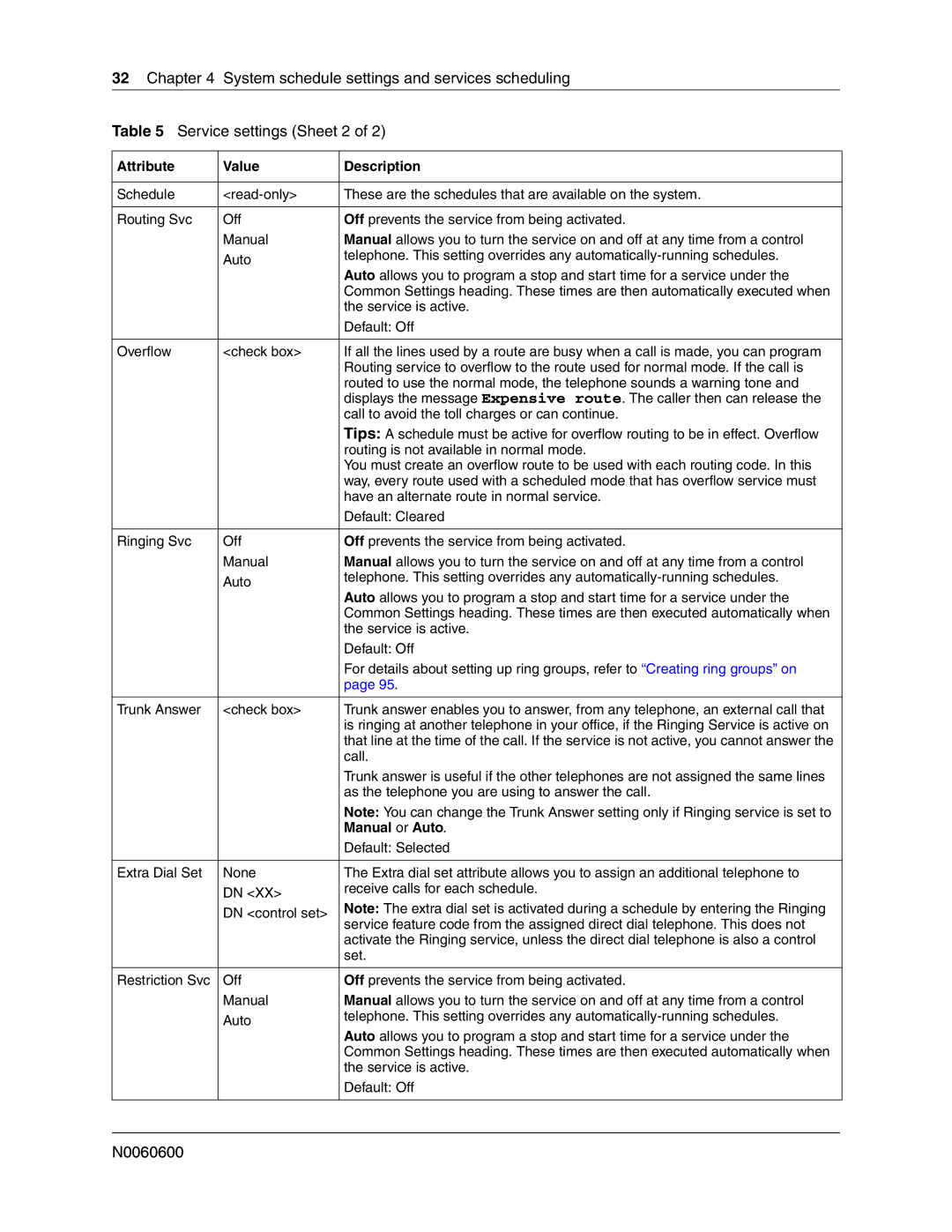
32Chapter 4 System schedule settings and services scheduling
Table 5 Service settings (Sheet 2 of 2)
Attribute | Value | Description |
|
|
|
Schedule | These are the schedules that are available on the system. | |
|
|
|
Routing Svc | Off | Off prevents the service from being activated. |
| Manual | Manual allows you to turn the service on and off at any time from a control |
| Auto | telephone. This setting overrides any |
| Auto allows you to program a stop and start time for a service under the | |
|
| |
|
| Common Settings heading. These times are then automatically executed when |
|
| the service is active. |
|
| Default: Off |
|
|
|
Overflow | <check box> | If all the lines used by a route are busy when a call is made, you can program |
|
| Routing service to overflow to the route used for normal mode. If the call is |
|
| routed to use the normal mode, the telephone sounds a warning tone and |
|
| displays the message Expensive route. The caller then can release the |
|
| call to avoid the toll charges or can continue. |
|
| Tips: A schedule must be active for overflow routing to be in effect. Overflow |
|
| routing is not available in normal mode. |
|
| You must create an overflow route to be used with each routing code. In this |
|
| way, every route used with a scheduled mode that has overflow service must |
|
| have an alternate route in normal service. |
|
| Default: Cleared |
|
|
|
Ringing Svc | Off | Off prevents the service from being activated. |
| Manual | Manual allows you to turn the service on and off at any time from a control |
| Auto | telephone. This setting overrides any |
| Auto allows you to program a stop and start time for a service under the | |
|
| |
|
| Common Settings heading. These times are then executed automatically when |
|
| the service is active. |
|
| Default: Off |
|
| For details about setting up ring groups, refer to “Creating ring groups” on |
|
| page 95. |
|
|
|
Trunk Answer | <check box> | Trunk answer enables you to answer, from any telephone, an external call that |
|
| is ringing at another telephone in your office, if the Ringing Service is active on |
|
| that line at the time of the call. If the service is not active, you cannot answer the |
|
| call. |
|
| Trunk answer is useful if the other telephones are not assigned the same lines |
|
| as the telephone you are using to answer the call. |
|
| Note: You can change the Trunk Answer setting only if Ringing service is set to |
|
| Manual or Auto. |
|
| Default: Selected |
|
|
|
Extra Dial Set | None | The Extra dial set attribute allows you to assign an additional telephone to |
| DN <XX> | receive calls for each schedule. |
| Note: The extra dial set is activated during a schedule by entering the Ringing | |
| DN <control set> | |
| service feature code from the assigned direct dial telephone. This does not | |
|
| |
|
| activate the Ringing service, unless the direct dial telephone is also a control |
|
| set. |
|
|
|
Restriction Svc | Off | Off prevents the service from being activated. |
| Manual | Manual allows you to turn the service on and off at any time from a control |
| Auto | telephone. This setting overrides any |
| Auto allows you to program a stop and start time for a service under the | |
|
| |
|
| Common Settings heading. These times are then executed automatically when |
|
| the service is active. |
|
| Default: Off |
|
|
|
